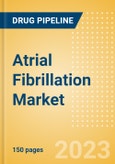This report covers the 8MM (US, France, Germany, Italy, Spain, UK, Japan, Canada) and provides an Excel-based forecast model for the Atrial Fibrillation (AF) market through 2032.
In 2022, the publisher estimated that the global AF market reached $14.53 billion across the 8MM. The US makes up the majority of total global sales, contributing $10.75 billion (74%) due to the large prevalent AF population in the US, early adoption of the new oral anticoagulants (NOACs), and higher prices for AF medications in this market. The publisher anticipates that the AF market will decline at a negative compound annual growth rate (CAGR) of 1.3%, to be worth approximately $12.8 billion by 2032. The US is expected to maintain its position as the market leader in 2032, contributing 74% towards the total global sales.
In 2022, the publisher estimated that the global AF market reached $14.53 billion across the 8MM. The US makes up the majority of total global sales, contributing $10.75 billion (74%) due to the large prevalent AF population in the US, early adoption of the new oral anticoagulants (NOACs), and higher prices for AF medications in this market. The publisher anticipates that the AF market will decline at a negative compound annual growth rate (CAGR) of 1.3%, to be worth approximately $12.8 billion by 2032. The US is expected to maintain its position as the market leader in 2032, contributing 74% towards the total global sales.
The major growth drivers in the AF market during the forecast period include the following::
- A total of five pipeline products, including four anticoagulants and one cardioversion agent, will launch during the forecast period, each of which will have a higher annual cost of therapy (ACOT) when compared with the cost of generic NOACs and the commonly used pharmacological agents, respectively
- Factor XI (FXI)/FXIa inhibitors, including abelacimab, asundexian, and milvexian, will be welcomed by the many AF patients who are not treated with the currently available anticoagulants due to bleeding concerns
- In the 8MM, the number of 12-month total prevalent cases of AF treated is expected to increase during the forecast period, which will drive sales
- Continued increases in AF awareness will improve diagnosis rates
The major barriers to growth in the AF market during the forecast period include the following::
- All four NOACs will face generic erosion as their patents expire over the forecast period
- The AF market is crowded with inexpensive generic products for the maintenance of rate and rhythm control. The high use of these products is expected to continue throughout the forecast period, presenting a stiff barrier of entry for pipeline drugs
- High cost of FXI/FXIa inhibitors compared to the NOAC generics will likely hinder patient uptake
Key Highlights
- In 2022, the publisher estimated that the global AF market reached $14.53 billion across the 8MM, and anticipates that it will decline at a negative compound annual growth rate (CAGR) of 1.3%, to be worth approximately $12.8 billion by 2032
- This decline in sales is due to the fact that novel oral anticoagulants (NOACs) will face generic erosion as their patents expire over the forecast period. In addition, the high cost of upcoming FXI/FXIa inhibitors compared to the NOAC generics will likely hinder patient uptake
Scope
- Overview of AF, including epidemiology, symptoms, diagnosis, and disease management
- Annualized AF therapeutics market revenue, cost of therapy per patient, and treatment usage patterns forecast from 2022 to 2032
- Key topics covered include strategic competitor assessment, market characterization, unmet needs, clinical trial mapping, and implications of these factors for the AF therapeutics market
- Pipeline analysis: comprehensive data assessing emerging trends and mechanisms of action under development for AF treatment. The most promising candidates in late-stage development are profiled
- Analysis of the current and future market competition in the global AF therapeutics market. Insightful review of the key industry drivers, restraints and challenges. Each trend is independently researched to provide qualitative analysis of its implications
Reasons to Buy
- Develop and design your in-licensing and out-licensing strategies through a review of pipeline products and technologies, and by identifying the companies with the most robust pipeline
- Develop business strategies by understanding the trends shaping and driving the 8MM AF therapeutics market
- Drive revenues by understanding the key trends, innovative products and technologies, market segments, and companies likely to impact the 7MM AF therapeutics market in the future
- Formulate effective sales and marketing strategies by understanding the competitive landscape and by analyzing the performance of various competitors
- Identify emerging players with potentially strong product portfolios and create effective counter-strategies to gain a competitive advantage
- Organize your sales and marketing efforts by identifying the market categories and segments that present maximum opportunities for consolidations, investments and strategic partnerships.
Table of Contents
1 Atrial Fibrillation: Executive Summary
2 Introduction
3 Disease Overview
4 Epidemiology
5 Disease Management
6 Competitive Assessment
7 Unmet Needs and Opportunity Assessment
8 R&D Strategies
9 Pipeline Assessment
10 Pipeline Valuation Analysis
11 Current and Future Players
12 Market Outlook
13 Appendix
List of Tables
List of Figures
Companies Mentioned (Partial List)
A selection of companies mentioned in this report includes, but is not limited to:
- Bayer
- Johnson and Johnson
- Bristol Myers-Squibb
- Daiichi Sankyo
- Pfizer
- Anthos Therapeutics
- Cadrenal Therapeutics
- Boehringer Ingelheim
- InCarda Therapeutics








